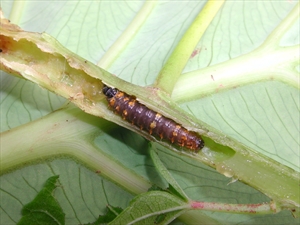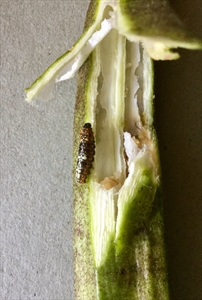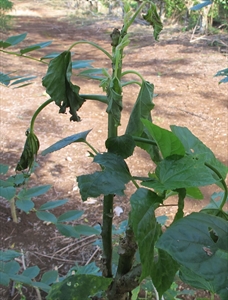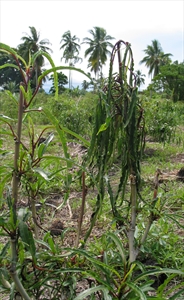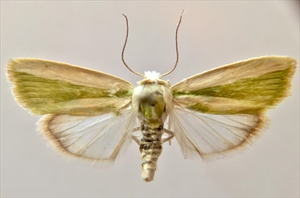Bele shoot borer, spotted bollworm, spiny bollworm
Pacific Pests, Pathogens, Weeds & Pesticides - Online edition
Pacific Pests, Pathogens, Weeds & Pesticides
Bele (Abelmoschus) shoot borer (023)
Earias vittella
Asia, Africa, Oceania. It is recorded from Australia, Fiji, Guam, Federated States of Micronesia, Northern Mariana Islands, Palau, Papua New Guinea, Samoa, Solomon Islands, Tonga, and Vanuatu.
The caterpillar attacks bele (aibika, sliperi kabis, island cabbage, Abelmoschus manihot), okra, hibiscus, and tomato.
Caterpillars do the damage by feeding inside the stems (Photos 1-3). The tips and leaves wilt and die (Photos 4&5). Caterpillars also feed inside fruits and pods of cotton and okra. Adult moths lay eggs at night, singly, on shoots, buds and young fruit.
Eggs are light blue-green, round, and about 0.5 mm across. They gradually change to brown just before hatching; they hatch into caterpillars in the early morning, after 3-7 days. The caterpillars may move some distance before boring into the soft growing parts of the plant to feed (Photo 6). They are grey-brown with orange spots and a black head. The body is up to 18 mm long and 3 mm wide, with two pairs of fleshy bumps on each body segment. They are full-grown after 9-17 days.
Mature caterpillars spin a silken cocoon, which is brown, felt-like, and shaped like an upside-down boat. Cocoons are fastened to the plant, to debris on the ground, or within cracks up to 30 cm deep in the soil. Inside the cocoon, the caterpillar turns into a pupa that is about 13 mm long, with three small spikes on its tail. The pupa lasts for 1-2 weeks, before it splits open and an adult moth emerges.
Adults live for up to 1 month, feed on nectar, and lay up to 500 eggs. Adults are 12 mm long, with a wingspan of about 20 mm (Photo 7). They are mostly white, with a central green wedge pattern running along their front wings.
In Fiji, there are reports of the shoot borer destroying about 20% of the okra crop, and in India it is a major pest of cotton bolls. In Solomon Islands, it is the most common concern of farmers attending plant health clinics.
Look at the stem tips and leaves to see if they are wilting and dying. Look closely for small holes in the stem below the dying tip. The caterpillars push their waste (frass) out of these holes, and this is often very noticeable (Photo 5). Break the stem near this hole to find the caterpillar in its tunnel.
NATURAL ENEMIES
Small wasps attack the eggs, caterpillars and pupae, and lacewings and ladybird beetles eat the eggs. It is important to think about these natural enemies when considering how to control Earias. If insecticides are used, choose ones that do not kill these beneficial insects. Preferably, use those that are allowed under organic vegetable production.
CULTURAL CONTROL
Before planting:
- Earias is less abundant during wet, humid weather; therefore, growing crops during the wet season may be effective.
During growth:
- When shoots wilt, look for the hole in the stem (Photo 5) and cut out the shoot several centimetres below it, making sure that the caterpillar has been removed.
- There are no known resistant varieties in Pacific island countries; however, look carefully to see if some types are less attacked than others, and plant more of those.
After harvest:
- After harvest, and if plants are severely attacked, pull them all out and burn them; stop growing the cabbage for a few weeks, and then plant the crop in a new garden.
CHEMICAL CONTROL
Populations of Earias tend to build up slowly, so only two or three applications of pesticide may be needed to reduce numbers in a crop.
- Use neem, derris, pyrethrum or chilli (see Fact Sheet no. 56). If these are used, add soap to help the chemical reach the caterpillars within the shoots.
- Alternatively, use commercial biopesticides, e.g., spinosad (the product is called Success) or Bt - Bacillus thuringiensis var. kurstaki.
- If using Dipel, note the following:
- Ensure that Bt covers the plants; caterpillars will only die if they eat Bt.
- Eggs are not susceptible to Bt.
- Use Bt as soon as damage is seen.
- Small larvae are more susceptible to Bt than fully grown ones.
- Synthetic pyrethroids are likely to be effective, but will also kill natural enemies.
--------------------
Note, derris (Derris species) contains rotenone, an insecticide, often used as a fish poison; it should be used with caution. The commercial derris insecticide is made from Derris elliptica.
____________________
When using a pesticide, always wear protective clothing and follow the instructions on the product label, such as dosage, timing of application, and pre-harvest interval. Recommendations will vary with the crop and system of cultivation. Expert advice on the most appropriate pesticides to use should always be sought from local agricultural authorities.
AUTHORS Grahame Jackson, Mani Mua & Helen Tsatsia
Information from MAF Plant Health & Environment Laboratory (2011) Spotted Bollworm (Earias vittella): PaDIL - http://www.padil.gov.au; and from CABI (2019) Earias vittella Crop protection Compendium (https://www.cabi.org/cpc/datasheet/20306). Photos 4&5 Graham Teakle, Canberra.
Produced with support from the Australian Centre for International Agricultural Research under project PC/2010/090: Strengthening integrated crop management research in the Pacific Islands in support of sustainable intensification of high-value crop production, implemented by the University of Queensland and the Secretariat of the Pacific Co2019) mmunity.
